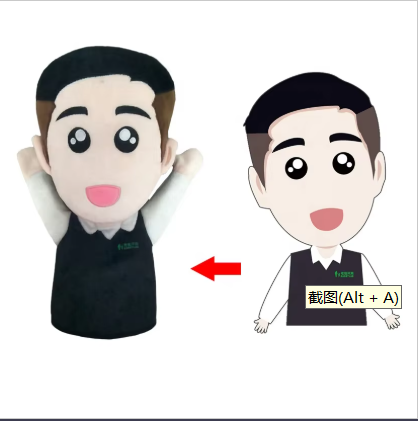Choosing the Best Fabrics for Plush Hand Puppets
Fleece: Softness and Durability Combined
Fleece fabric works great for kids' hand puppets because it's soft yet durable enough to withstand all sorts of playtime abuse. Puppet makers love how it doesn't fray easily and wipes clean when little hands get messy. After many washes, most fleeces keep their shape and texture too something parents appreciate since kids tend to toss these toys around quite a bit. What really stands out though is the wide range of bright colors and fun patterns available in fleece materials. Bright reds, blues, and even animal prints let puppet designers create characters that spark kids' imaginations during story time. A recent study published by textile scientists showed that quality fleeces survive dozens of laundry cycles without breaking down, which explains why so many toy manufacturers stick with this material despite cheaper alternatives on the market.
Minky Fabric for Premium Texture
Minky fabric feels super soft to the touch, which works great when kids want to interact physically with puppets. Available in all sorts of fun patterns too, these fabrics catch little eyes while they're playing around. Since most minky is made from polyester, it stands up pretty well against wear and tear, something really important since puppets get handled so much day after day. A lot of educators notice how kids respond better to toys that feel good in their hands, and minky definitely fits the bill here. That's why many puppet makers prefer working with minky fabric whenever possible, because it combines practicality with the joy factor that keeps children engaged during playtime.
Felt: Lightweight and Easy to Shape
When it comes to puppet making, few materials are as flexible as felt. Artists love working with it because they can cut out all sorts of shapes and add decorative elements easily. Felt cuts and sews pretty well too, which makes it great for folks getting started with their own puppet creations at home. The color options are pretty amazing too there's almost every shade imaginable, so crafters can match their puppets to whatever theme they have in mind. According to Craft Magazine, this material doesn't break the bank either when compared to other fabrics on the market. For people watching their budgets but still wanting to create something special, felt hits that sweet spot between cheap and creative.
Cotton Blends for Breathability
Puppet makers often turn to cotton blends when they need something that lets air through, since kids tend to get hot pretty fast during playtime. What makes these blends work so well is how they mix cotton's natural stuff with some synthetic additives that make them last longer. There are tons of different designs out there too, from cartoon characters to simple solids, so both children and their parents usually find something they like. Cotton has proven itself time and again in the world of toys because it stays soft even after repeated use, which explains why most plush hand puppets are made with this material when breathability and comfort matter most.
Essential Fillings for Structure and Softness
Polyester Fiberfill: Hypoallergenic Support
Most puppet makers go with polyester fiberfill when they want their plush creations to have good shape and feel nice and soft at the same time. The stuff is really light weight so handling the puppets doesn't get tiring during performances, plus it won't bother kids who might have skin issues or allergic reactions. One big plus point about this material is how tough it actually is. Even after being washed dozens of times, it still keeps its form without getting all flattened out, which means the puppets can last years instead of just a few months. Looking around at what's happening in the toy manufacturing world right now, polyester fiberfill continues to dominate as the go-to stuffing option for plush items because of all these practical reasons, though some artists occasionally experiment with alternatives.
Foam Inserts for Mouth Mechanisms
When making those flexible mouth parts for hand puppets, foam inserts really come in handy. EVA foam works great because it's tough enough to last but not too heavy, so puppeteers can move them around easily without worrying about sagging or warping. These foam pieces help keep puppets looking good even after lots of back and forth during shows or kids playing with them all day long. Puppet makers find that foam holds up pretty well over time, which makes sense why so many stick with it for their creations. Adding these foam components actually makes hand puppets feel more lifelike and responsive when interacting with audiences, something that stands out in both professional theater settings and home entertainment alike.
Durable Structural Components for Puppet Functionality
Plastic or Foam Mouth Plates
The decision between plastic and foam mouth plates matters quite a bit for puppet operators. Foam options are light on the hands, making them easier to move around and generally more comfortable when working for hours straight. Plastic alternatives offer something different though they're heavier but much tougher, giving that solid foundation needed for those exact mouth movements in performances. These two materials impact how the puppet actually moves and lasts over time. Foam tends to bend and flex naturally but will eventually show signs of wear from constant use. Plastic holds up much better in the long run despite feeling less forgiving at first. Most experienced puppet makers suggest thinking through what kind of shows the puppet will be doing and just how intense those movements need to be before settling on one material over another.
Reinforced Seams with Strong Thread
Good quality thread makes all the difference when it comes to reinforcing those high stress areas on a puppet where seams tend to fail. Upholstery thread works well for heavier duty applications while polyester offers decent strength at a lower cost, though compatibility with different fabric types matters too. A puppet needs strong seams to hold up against constant manipulation during performances without coming apart at the seams literally. Most toy manufacturers stick to heavy duty threads for child's playthings because safety regulations demand it, but even beyond compliance, reinforced stitching just makes sense for anything that gets handled repeatedly. Puppets made with proper seam reinforcement last much longer in the hands of performers who need reliable props show after show.
Safety Considerations for Child-Friendly Materials
Non-Toxic Certification Standards
When making puppet toys for kids, using materials that meet non-toxic standards really matters. Standards like CPSIA help keep harmful chemicals out of children's toys. After all, little hands often end up putting everything in their mouths during playtime. Groups such as ASTM International run thorough tests to check if materials actually meet those safety requirements. Looking back at past toy recalls shows just how important proper certification can be. Parents want peace of mind knowing their child isn't exposed to dangerous substances while playing. For anyone creating puppets meant for young audiences, going through the extra step of verifying material certifications isn't just good practice—it's practically necessary nowadays.
Avoiding Choking Hazard Accessories
Small detachable items on puppets pose real choking dangers, so it makes sense to avoid them whenever possible. Rather than going for those fancy little trinkets that just fall off, try something different like embroidery work or decorations that are stitched firmly into place. These options let makers get creative while keeping things safe. Good craftsmanship matters too when selecting materials for puppets. The right choices cut down on accident risks without making the puppet look boring. Statistics from the US Consumer Product Safety Commission show that toy-related choking remains a big problem, highlighting why careful planning during construction really counts. Strong stitching and no loose bits create puppets that work well and stay out of trouble at the same time.
Maintenance Tips to Preserve Material Quality
Gentle Washing Techniques for Fabrics
Keeping puppet fabrics looking good means knowing how to wash them properly for different materials. Cold water works best with mild soap when dealing with sensitive stuff like faux rabbit fur, PV fleece, or that really soft crystal fabric we all love. These materials just don't handle regular laundry well at all. Most folks who work with textiles will tell anyone who'll listen that letting things air dry instead of tossing them in the dryer keeps everything from getting ruined. Velvet and natural fibers especially need special attention. Spot cleaning usually does the trick, though sometimes dry cleaning becomes necessary if they get really dirty. Don't ever twist or wring out these fabrics either. Heat is the enemy here too. Just ask anyone whose puppet got messed up after being dried on high heat.
Storage Solutions to Prevent Damage
Good storage is really important if we want our puppet materials to last longer without getting damaged. Putting puppets inside breathable fabric bags keeps dust out and protects against moths. Keeping an eye on temperature and humidity in storage areas also makes a big difference in how well materials hold up over time. Take those fancy costumes made with fake rabbit fur or velvet for example they need to stay away from places where it gets too hot or cold otherwise they might shrink or lose strength. Taking some basic steps to maintain proper conditions around puppet collections actually extends their life quite a bit. Most people who work with textiles know that when things are kept in good conditions, they just don't show wear as quickly and keep their original feel much longer.
Frequently Asked Questions
What are some of the best fabrics for plush hand puppets?
The best fabrics for plush hand puppets include fleece, minky fabric, felt, and cotton blends as they offer durability, aesthetic appeal, and comfort.
Why is polyester fiberfill commonly used in plush hand puppets?
Polyester fiberfill is lightweight, hypoallergenic, and maintains its shape after multiple washes, making it ideal for plush hand puppets.
What factors should be considered in puppet safety standards?
Puppet safety standards should consider non-toxic certification of materials and design elements that reduce choking hazards.
How can puppet fabrics be preserved during maintenance?
Maintaining puppet fabrics requires gentle washing techniques using cold water and mild detergents, air drying, and appropriate storage solutions.


